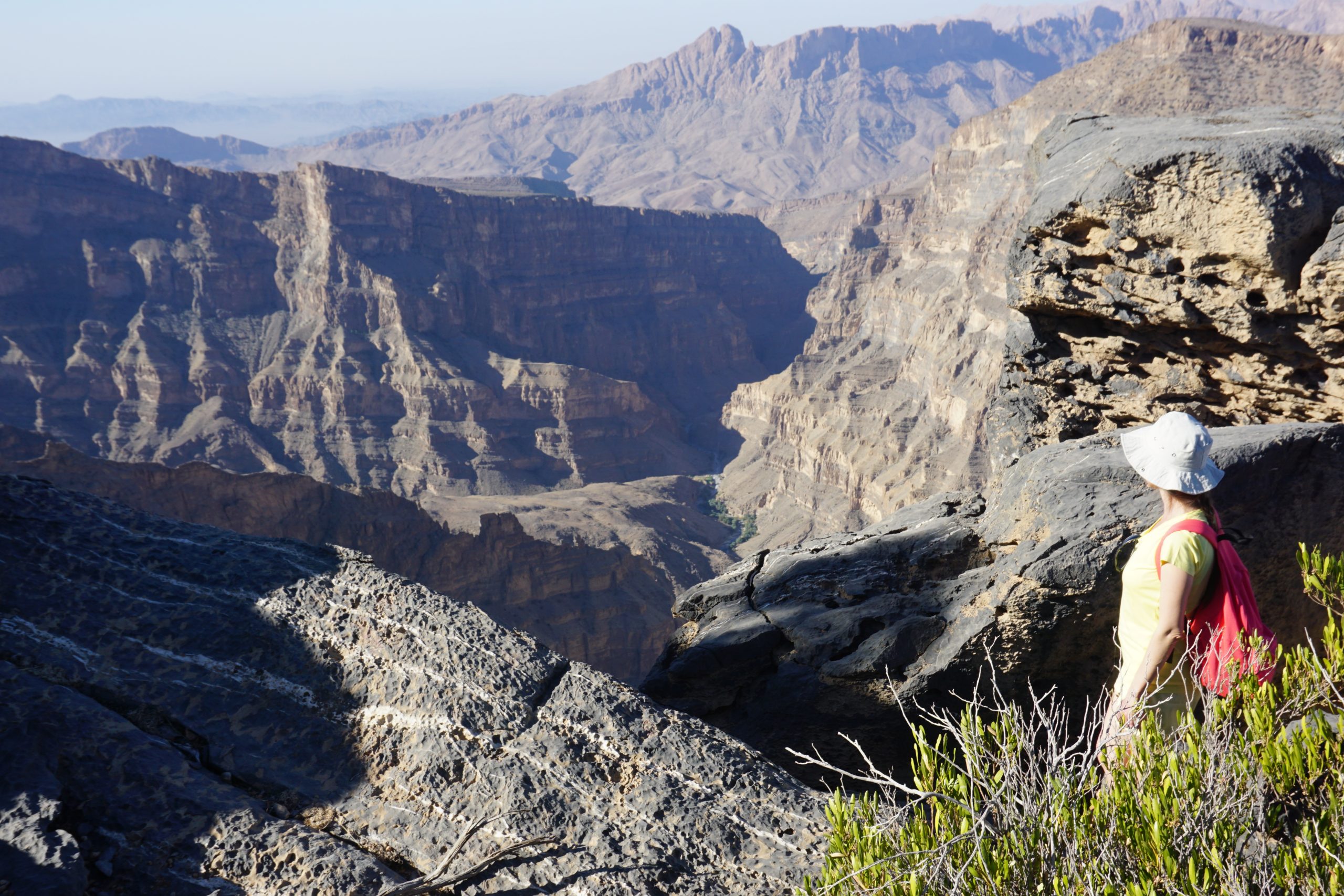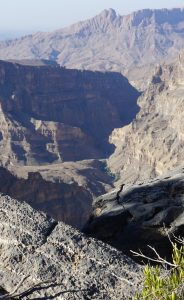OMAN – TRAVELING IN TIME OF PLAGUE
Reportage from the Arabian Peninsula
It would seem that May is a good month to write about travels. But in 2022 – only seemingly. After two years of dealing with the COVID-19 pandemic, on February 24 this year we heard about the unprovoked armed attack by the Russian Federation on sovereign Ukraine. Here, on the Vistula River, we have learned that there, on the Dnieper, there has been a war going on since 2014. This cannot be ignored!
* * *
Travelling is discovering the world for yourself and… for others.
As the Editor aptly noted, my last travel reportage appeared in “Echo Limanowskie” exactly five years ago. So let me start with an explanation – the 12-person trip to the Arabian Peninsula was planned over two years ago. Unfortunately, in 2020 year, a small coronavirus shook the entire huge planet Earth and the plans of our expedition. Instead of packing on the plane and on March 19 fly to Dubai, five days earlier, international passenger flights were banned from landing at airports in the Republic of Poland, airports were closed. We stayed in lockdown, had to sit back at home (isolation/quarantine). We could begin to undo the advance bookings, study the map, read a book and watch a movie about the mountains in Oman and to think about the end of the pandemic…and to think about the end of the pandemic… Oman for two years was for me just a hallucination. The inspiration to resume the preparations was a social meeting on November 14 last year. Reports from the end of 2021 year indicated that this year tourists will mainly go to Greece, Egypt, Turkey, Spain, Bulgaria, Croatia, Italy, the United Arab Emirates and Cyprus.
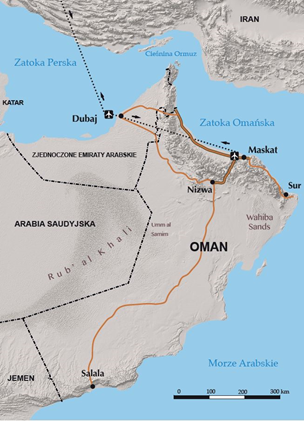
So why Oman? For each of the participants of the expedition, the reasons were different. For me, the nature and sports context is important: mainly trekking in the majestic mountains and the exploration of many kilometres of canyons and ravines, the so-called wadi. And also a visit to the picturesque desert and the atmosphere of centuries-old culture and tradition – after all, it is an Arab country. In my university English-speaking groups there are e.g. students from Oman, hence the desire to get to know the country better, because the general information and ideas about it are not rich. There is not much printed information about Oman. I am using the guide entitled “The rough guide to Oman” (2nd edition, 2018) and “Oman” by Pascal Publishing House (Bielsko-Biała 2016). You can hardly find a few journal articles (e.g. in National Geographic Polska or Traveler). It’s easiest to read something on the Internet. Sometimes I hear that the Sultanate of Oman is a small country in the Middle East. Its location is shown on the map. It is worth adding that, although its population corresponds to one-eighth of the population of Poland, its area is similar to that of our country. So a good conclusion – not such a small country, but it will not be crowded.
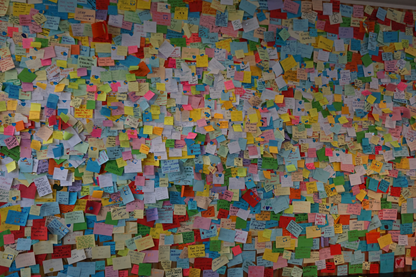
On Sunday, March 27, 2022, 10 people from the original team and two new participants, including my daughter Ania, set off on the expedition. In the anti-covid regime, with EU COVID certificates and in face masks, we go from Warsaw by night flight to the capital of the United Arab Emirates – Dubai. We have a further flight to the capital of Oman in the evening, so we spend half a day visiting Expo 2020 Dubai. The World Exhibition was planned for the turn of 2020 and 2021, but due to the pandemic it was postponed to the period from October 1, 2021 to March 31 this year. In short, at the last minute we got to the exhibition which was a stunning event. The variety of cultural, scientific and technical achievements (including external architectural forms) of nearly 200 countries and nations of the world, presented in one place on an area of over 400 hectares, made a great impression. Of course, we could not fail to enter the Ukrainian pavilion, which was very popular. Full surprise inside. The interior of the building was glued by visitors from all over the world with thousands of cards with expressions of support for the fighting Ukraine and with “wishes” for the aggressor, including the famous
„Русский военный корабль, иди …”.
Late in the evening we are already in Muscat – the capital of the Sultanate of Oman. At the airport, we rent three 4×4 cars, which are an important element of our trip. The crew of one Mitsubishi consists of: Mirek as the driver, with his wife Renata, my daughter Ania and me. The second Mitsubishi is drived by Jacek, assisted by his wife Ela, Mary and Bożenna, and Toyota by Leszek, assisted by his wife Danusia and the other Mirek with his wife Katie. In a hotel in the city centre, we need to rest a bit with “drops” of quince, because in this country all alcohol is strictly rationed. Also in our group. What else is not in Oman?
For example, there is no railway network. But there are decent roads and highways, where there are no so-called traffic jams (although there are quite good cars and very cheap gasoline – about PLN 2,70/litre!). In Poland, rivers and lakes form the basis of the hydrological system. In Oman, annual precipitation varies from 100 mm on the coast to 300-500 mm in mountainous areas. There are no permanent rivers, and dry riverbeds of periodic or episodic rivers are the wadis of interest to us. The country functions thanks to a developed system of irrigation canals – aflaj. They have been built for over 2,000 years and are still the backbone of agriculture and rural infrastructure. There are also no forests – forested areas constitute less than 0.1% of the country’s area (for comparison, in Poland they cover about 31% of the area). Only in the depths of the canyons, where there is a little water, there are palm groves, with a predominance of the date palm tree. Its fruits – dates, due to their energy value, are recommended, among others during intense physical exertion.
On Tuesday, we set off on the road shown on the map.

First to the mountains. But not the shortest route, but along the coast from the Gulf of Oman towards the west to Barka (Birka). Then, in the city of Ar Rustaq (Rustak), we do more food shopping (we will be on our own board for a few days) and we enter the Al-Hajar Mountains. The idea of the trip is to use off-road but passable roads as much as possible. At times the road becomes exposed, quite difficult for drivers, but extremely interesting for passengers. After travelling several dozen kilometres, periodic stops become necessary, as cars signal technical problems. We try to make it to the accommodation base before dusk, because driving at night in such conditions is an additional challenge. After crossing the main mountain range, we “catch” some asphalt. We arrive in the dark, but happily to the village of Al Khitaym, located at an altitude of about 1900 m above sea level. We stay and spend the three nights at Canyon Rest House and Sama Heights Resort Jebel Shams.

The next day we go to the so-called the Omani Grand Canyon in the highest range of Al-Hajar Mountains. The Grand Arabian Canyon, formed by two valleys: Wadi Ghul and Wadi Al Nakhar. It is said to be the second deepest canyon in the world, but since I got to know the famous Peruvian Colca Canyon, I stopped being interested in their ranking. There are dozens of them in Oman alone. This one can be admired from the edge, from the trail “suspended” on its wall and from the bottom. We start the exploration with a look into the canyon, and then we have a relatively easy, but also beautiful trekking on the slopes of Wadi Al Nakhar, called “Balcony Walk”. At the end point, after a few kilometres of hiking, we come to the former village of As Sab and a terrace with fantastic views. After returning to the parking lot, it turns out that under the cars and on some trees there are ubiquitous goats looking for shade and food.
During our two weeks in Oman, not a single drop of rain fell. In the mountains, we do not have much contact with water in nature. We see it only on March 31 at the bottom of the Grand Canyon, after driving about 25 km and after a short trek. So we can plunge into a small pool or hike up the valley to the lake hidden in the rocks. However, in general, during the whole expedition, in order to replenish the body’s water reserves, we often stop at roadside stalls with watermelons, which we eat a lot.

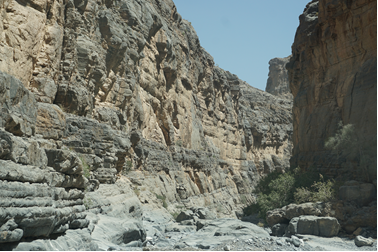
Usually, at dinner, we make a detailed plan for the next day. On Thursday evening it turns out that the individual program for Friday wins, e.g. swimming in the canyon. Only me and Ania decided to go to the highest peak in Oman – Jebel Shams. It is the “Mountain of the Sun” because its top is illuminated by the first rays of the rising sun. The height of the summit, according to various sources, ranges between 2,980 and 3,075 m above sea level. Here is a curiosity – some information shows that you can reach the summit by car. True, but only to a closed military base that is inaccessible for tourists. However, we take up the challenge and on April 1, “at the crack of dawn“, we set off on a day-long hike towards Qarn Al Ghamaydah (approx. three thousand meters above sea level), the southern peak of Jebel Shams, along the trail marked with a yellow, white and red “flag”. It is well marked out, but in many places we are helped by mounds of stones, additional green arrows and sometimes a slightly trodden trail. It is impossible to hike fast, because practically the entire road leads over the rim of the Grand Canyon, which is a great observation deck. We admire the panorama of the mountains and the canyon in all its glory, illuminated by the sun’s rays in the morning. We can see it from the side of the trail leading to the “civil” summit. Walking along the rim of Al Nakhar means we have to traverse the deep gorges of its former or potential “tributaries”. Such “up and down” topographically resembles a hike through the Polish Beskid Wyspowy, where you often go from top to top, crossing deep valleys, but in terms of nature there is a huge difference – there is no forest, only a rocky semi-desert, covered with shrubs here and there. We decided to hike up only until 1 p.m. in order to return to the starting point before dark. All the hikers we met always asked us if we had headlamps and if we needed water. And it is worth adding that we passed only 10 individual hikers while hiking back and forth. Punctually at 6 p.m. we are at our starting point – in front of Sama Heights Resort Jebel Shams, where we stay for dinner. About 35 thousand steps behind us.
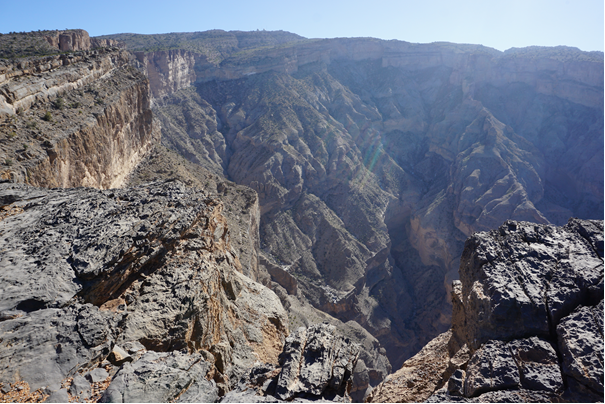
Usually, at dinner, we make a detailed plan for the next day. On Thursday evening it turns out that the individual program for Friday wins, e.g. swimming in the canyon. Only me and Ania decided to go to the highest peak in Oman – Jebel Shams. It is the “Mountain of the Sun” because its top is illuminated by the first rays of the rising sun. The height of the summit, according to various sources, ranges between 2,980 and 3,075 m above sea level. Here is a curiosity – some information shows that you can reach the summit by car. True, but only to a closed military base that is inaccessible for tourists. However, we take up the challenge and on April 1, “at the crack of dawn“, we set off on a day-long hike towards Qarn Al Ghamaydah (approx. three thousand meters above sea level), the southern peak of Jebel Shams, along the trail marked with a yellow, white and red “flag”. It is well marked out, but in many places we are helped by mounds of stones, additional green arrows and sometimes a slightly trodden trail. It is impossible to hike fast, because practically the entire road leads over the rim of the Grand Canyon, which is a great observation deck. We admire the panorama of the mountains and the canyon in all its glory, illuminated by the sun’s rays in the morning. We can see it from the side of the trail leading to the “civil” summit. Walking along the rim of Al Nakhar means we have to traverse the deep gorges of its former or potential “tributaries”. Such “up and down” topographically resembles a hike through the Polish Beskid Wyspowy, where you often go from top to top, crossing deep valleys, but in terms of nature there is a huge difference – there is no forest, only a rocky semi-desert, covered with shrubs here and there. We decided to hike up only until 1 p.m. in order to return to the starting point before dark. All the hikers we met always asked us if we had headlamps and if we needed water. And it is worth adding that we passed only 10 individual hikers while hiking back and forth. Punctually at 6 p.m. we are at our starting point – in front of Sama Heights Resort Jebel Shams, where we stay for dinner. About 35 thousand steps behind us.
It’s Saturday April 2nd. Just today, in this calendar year, the ninth month of the Muslim (or lunar) calendar begins in Oman, known as Ramadan. This limits our dietary options, but allows us to touch the local culture and traditions. We leave the base in the mountains and go to the historic city of Nizwa, with a population of around 70,000. On the way, near the town of Al Hamra, we stop in the mountain village of Misfat al Abriyeen (approx. 1000 m above sea level) to take a walk in a picturesque scenery, among densely built clay houses. In the afternoon, we are in Nizwa, located at the foot of the Al Jebel al Akhdar mountains at an altitude of approx. 490 m above sea level. We go to visit, among others fort and castle. The imposing tower with a diameter of 36 meters is the largest in the Arabian Peninsula. Both the walls and the rich exhibition are in a very good condition after renovation. In the evening we go to the local souk – western and eastern bazaar, which in my opinion is a bit like a modern shopping centre. Only after sunset does the trade come to life and we can have dinner in the restaurant.
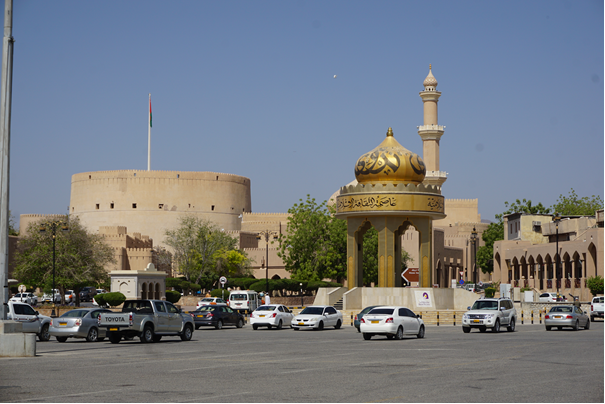
On the second day, we receive breakfast after sunrise, but discreetly – in the room. And then we go to the Jebel Akhdar mountains (which means “Zielona Góra”) to the plateau – The Sayq Plateau. In cities and in low-lying areas, the temperature reaches 40oC at the beginning of April at noon. Only at an altitude of 1500-2000 m above sea level it is cooler by a dozen or so degrees. This is the reason why luxury hotels and residential buildings are erected at these heights. We plan to trek the hill of the Al Ayn wadi covered with green vegetation to the village of Ash Shirayjah. The path leads along terraced farmlands and mountain villages, in places we walk along a dry irrigation canal (falaj).After hiking and car trips in the canyon, we are so hungry that we sit down to eat before sunset. As it will soon turn out – delicious.
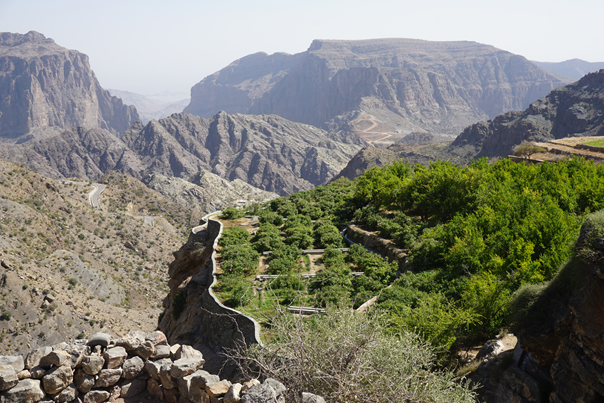
On Monday, April 4, we leave Nizwa after the morning walk along the alleys of the old part of the city. We have about 185 km to travel (partly by the highway), to the village of Al Raka next to Al Mintirib, which is the “gateway” to the Wahiba Sands desert. After a short rest and relaxation in the pool of the Bidiya Oasis villa, we set off to the desert. Driving on it requires bleeding some air from the wheels and a special driving technique. In order not to get stuck in the desert sands, we take a local guide to help. After a few “rallies” and attempts to pull the car out of the sand, we stop at a high dune, because our goal is to admire the sunset, which looks fascinating in the desert. And in the late evening we eat local skewers and swim in the pool.
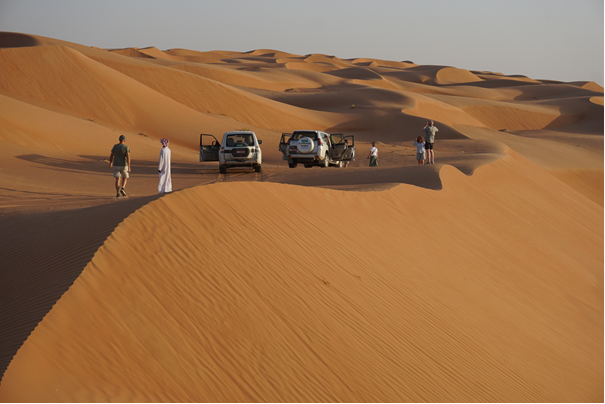
The next day we leave Al Raka with the intention of reaching the shores of the Arabian Sea, which is the northern part of the Indian Ocean. We just need to pump up the wheels in the cars and there is a straight road ahead, about 120 km, mostly on the highway. However, we leave the main road very quickly to look into another canyon – Wadi Bani Khalid. It is said to be the most popular wadi in Oman. First we go and then we go to the point where we can swim in a large pool. Of course, we are subject to all Islamic restrictions on swimwear, which in the case of ladies and gentlemen should be one-piece, covering the arms to the elbows and the legs to the knees. A special “guard” watches over this. At the urging of Danusia, together with Mirek and a local guide who illuminated the pathway, I went deeper into the Muqal cave, at the end of which there was another small lake. It was also getting warmer, so it was time to end this speleological escapade and crawl out of the cave. Swimming and wandering through the bottom of the canyon, we return to the cars and then to the main road – there are still about a hundred kilometres left to the coastal city of Sur.
According to the program of the trip, we reach the “relaxation zone”: very good hotel conditions, the sea, beaches. Wednesday is to be a “seaside” day. After breakfast, we visit the local shipyard, which builds traditional boats and wooden ships. Later, looking for a beautiful beach and swimming in the Arabian Sea for several hours. In the afternoon, we visited the Ras Al Jinz Turtle Scientific and Visitor Centre located on the eastern tip of the Arabian Peninsula. We are short, because this is not the time to see these reptiles. You would need to come preferably during the breeding season, from June to September, when it is warmest in Oman, and go to the beach in the evening or in the morning.
On Thursday, April 7, we spend an interesting day in the canyons. First, we drive several dozen kilometres along the highway, passing the industrial zone (power plant, refinery, LNG), and we reach the “gate” of Wadi Shab. To get to the other side of the estuary, we use a small boat and set out deeper into the canyon, initially under the shade of date palms, banana trees and other trees. After a few kilometres we come to a place where it is impossible to go any further. We have to jump into the water and swim up the river. In some places the stream is shallower and we can wade in the water and swim again. In this way, we get to the next reservoir, from which we can only swim under water or squeeze through the crack in the rocks to the last “lake”, into which the waterfall falls. The place is quite unusual. Above us there are rocks, between which rays of sunlight reach. After a long while, we turn back, swimming and wading, to the place where we left our handy backpacks and clothes. Going down the river, we come to the crossing to the parking lot, where in the meantime a large herd of goats has gathered. We managed to get out of the “lap” and we go to the nearby Wadi Tiwi, where there is a winding mountain road, exceptionally with a concrete surface. We cover several kilometres, passing more villages on the way. When the road ends, we can go for a swim in the “pool” under the waterfall.
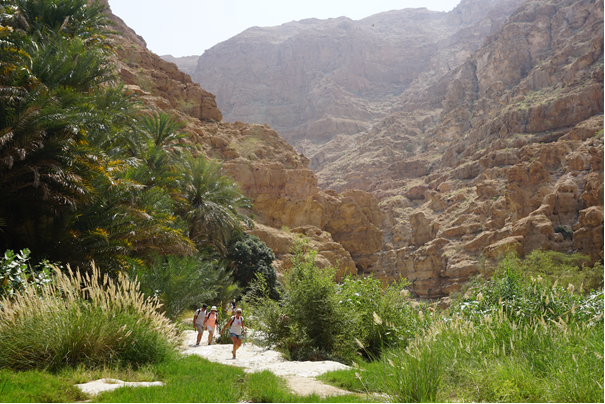
The next day we leave Sur for Muscat. A stop at Hawiyat Najm Park is intended for resting and swimming in the turquoise water of the sinkhole (Bimmah Sinkhole). It is located about 200 meters from the shore on the Gulf of Oman, so fresh water mixes with seawater, giving it a wonderful color. Oman people associate various legends and theories with this place (e.g. that it is the effect of a meteorite impact). And as I am talking about the legends, I will add that Oman is associated with a story about the adventures of Sinbad the Sailor, who supposedly came from the city of Sohar, presented in the “Book of One Thousand and One Nights“.
We devote Saturday to getting to know the most important capital facilities. We start the morning with a visit to the extraordinary Great Mosque of Sultan Kabus – the largest temple in this country (opening year 2001). The scale and splendor of this relatively new facility is reflected, for example, in a floor covering that has been woven by 600 women for four years. In order to see the interior of the mosque, strict clothing conditions must be met. Appropriate robes are available for ladies at a nearby boutique. The Royal Opera Theater in Muscat (opening 2011) is also impressive. At the end of these tourist peregrinations, we go to the Al-Alam Palace of the Sultans of Oman, located on the Gulf of Oman. This palace is not open to the public. So we go to the nearby mountains to look at the city from a different perspective. We end our stay in the capital of Oman with an afternoon sunbathing and swimming in the blue waters of the Gulf of Oman. Our adventure in Oman ends on Sunday, April 10th. From Muscat, we fly to Dubai, and then, after changing the terminal, we transfer to a flight to Warsaw. It was interesting, nice and safe in these dangerous times.
For those interested in a reporter’s story about modern Oman from the reign of Sultan Kabus Ibn Sa’id, who died in January 2020, I recommend Marek Pindral’s book “Oman in the shadow of minarets” (Bernardinum Publishing House, Pelplin 2015) and Agata Romaniuk entitled “From love? I feel for it. Tales from Oman” ”(Edition 2nd, Poznań Publishing House, Poznań 2019).
It is worth adding that Sultan Kabus was genuinely adored by his subjects and honored with universal respect. He ruled for half a century, retaining absolute power, but most decisions were made on the basis of consultation and negotiation. He is recognized as the creator of the power of Oman. He lifted the country out of poverty, modernized it and opened it up to world trade, while remaining neutral in most conflicts in the region. Suffice it to say that in 1970 he took over the country from his father, where there were only a few kilometres of asphalt roads, slavery was legal, and illiteracy affected about 90 percent of citizens. In Oman, which, inter alia, because of its climate and culture, it is considered exotic, we were brief, but we saw in it the normality that is desired in many countries that are not considered exotic. You can look at Oman through the prism of economy. It is a country for which the Quality of Life Index is approximately 174 (i.e. at the Luxembourg level, for Poland it is 140).
It cannot be denied that Oman has charmed us. The expedition had been interesting from the beginning, but in reality it was even more interesting. So Oman, nomen omen, no longer a hallucination. Nevertheless, at the end I must say that the month of May in terms of nature is beautiful in Poland. The greenery surrounding us, especially in the garden, park, square or forest, blooming forsythia and fruit trees and fragrant common lilac, rape fields, singing birds contrast with the dry, hot climate and the landscape devoid of vegetation in Oman.
Warszawa, May 29, 2022
